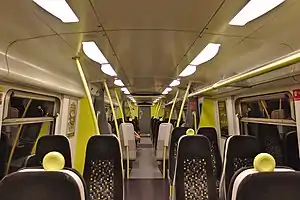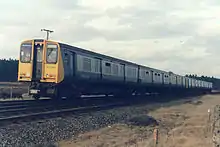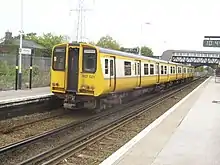British Rail Class 507
The British Rail Class 507 is a type of electric multiple-unit (EMU) passenger train built by British Rail Engineering Limited at Holgate Road carriage works in two batches from 1978 to 1980. They were the second variety of British Rail's standard 1972 design for suburban EMUs derived from PEP stock, which eventually encompassed 755 vehicles and five Classes (Class 313/314/315/507/508). The 507s were the first variant to be 750 V DC third rail only. They have worked on the Merseyrail network from new, and continue to do so, having been refurbished by Alstom's Eastleigh Works. The Class 507 unit is now 43 years old, making them among the oldest units still in service on the UK mainland rail network, after the Class 313 and Class 508.
| British Rail Class 507 | |
|---|---|
.jpg.webp) 507027 at Cressington railway station in 2013 | |
 The interior of a Merseyrail refurbished Class 507 | |
| In service | 1 November 1978 – present |
| Manufacturer | BREL |
| Order no. |
|
| Built at | Holgate Road carriage works |
| Family name | BREL 1972 |
| Replaced | |
| Constructed | 1978–1980[1] |
| Refurbished |
|
| Number built | 33 sets |
| Number in service | 32 sets |
| Number scrapped | 1 set |
| Formation |
|
| Diagram | |
| Fleet numbers | |
| Capacity |
|
| Operator(s) | Merseyrail |
| Depot(s) | |
| Line(s) served |
|
| Specifications | |
| Car body construction | Steel underframe and body frame, aluminium body and roof[2] |
| Car length | 19.8 m (65 ft 0 in) (over body)[2] |
| Width | 2.82 m (9 ft 3 in) (over body)[2] |
| Height | 3.582 m (11 ft 9.0 in)[2] |
| Floor height | 1.146 m (45.1 in)[2] |
| Doors |
|
| Articulated sections | 3 |
| Wheelbase | 14.170 m (46.49 ft) (bogie centres, per car)[2] |
| Maximum speed | 75 mph (121 km/h)[2] |
| Weight |
|
| Traction motors | 4 × GEC G310AZ of 82.125 kW (110.131 hp) (per motor car) |
| Power output | Total: 656 kW (880 hp) |
| Train heating | Electric-ducted warm air[2] |
| Electric system(s) | 600/750 V DC third rail[1][2] |
| Current collection method | Contact shoe |
| UIC classification | Bo'Bo'+2'2'+Bo'Bo' |
| Bogies | BX1[1][2] |
| Braking system(s) | Electro-pneumatic Disc and rheostatic[1] |
| Safety system(s) | |
| Coupling system | |
| Multiple working | Within class and Class 508 |
| Headlight type | Fluorescent and tungsten[2] |
| Track gauge | 1,435 mm (4 ft 8 1⁄2 in) standard gauge |
History
With the Class 502 units life-expired, unable to cope with the demands of the new "Link" tunnel and approaching 40 years old, by 1977 a replacement was sought. Owing to the success of the Class 313 fleet on suburban services from King's Cross, four sets were temporarily transferred to Merseyside and based at Hall Road TMD. Sets 313013/063[4] were used for clearance trials on the Southport, Ormskirk and Kirkby-Garston lines. The results showed that a similar type of stock would be suitable for the Merseyrail Northern Line.
Initially, 47 sets were ordered (507001-507047) but cost issues forced this number to be reduced to 38 units, then 30 by early 1978 when the first sets were under construction. Ultimately, 33 units were built between September 1978 and October 1979. The first set was delivered to Birkenhead North depot during September 1978,[5] with the first test run taking place on 9 October 1978.[5]
On 25 October 1978, a Royal Special involving units 507001 and 507002 conveyed HM the Queen and several other VIPs on a special service between Moorfields and Kirkby. Following the journey, she declared the new-look Merseyrail network officially open.[6] The first passenger working occurred on 1 November 1978 with 507001 working the 0739 Southport-Liverpool Central with a commemorative headboard.[5] It worked between Liverpool and Southport for the remainder of the day, while 507002 operated between Liverpool and Ormskirk. Further 507s steadily entered service and the 502s were in turn withdrawn. By mid 1980, Northern Line services were entirely in the hands of the 507s, and all of the sets were in service by October 1980.[5]
Following privatisation, the 507s were used interchangeably between both the Northern Line and the Wirral Line, working a further four routes regularly. A host of new liveries appeared following sectorisation of British Rail. The remaining 32 units were refurbished by Alstom Eastleigh during 2002-2005. They received new interiors, CCTV, light clusters dot matrix displays and the 2+3 seating replaced with 2+2 seats.[7] Unit 507033 was the last Merseyside set to be refurbished, entering service having been named "Cllr George Howard" in August 2005.[8][9]
Incidents
507022 was written off as a result of a serious collision with 507004 at Kirkdale TMD on 30 September 1991.[10] Driving motor 64388 is now in 507004, as the latter's was damaged beyond repair, and the other motor carriage, renumbered, went to Glasgow-based 314203. To date, this is the only withdrawn Class 507 set.
Collisions with buffer stops at terminal stations have also occurred. Sets 507029 and 507032 both received damage due to overrunning at Kirkby in 1991 and 1997 respectively. Set 507019 was involved in a collision at West Kirby on 11 January 2007[11] and carriage 64423 had to be sent to Crewe Works for repair.
On 30 June 2009 unit 507002 without a driver rolled out of Kirkdale TMD, derailing at a set of points further down.[12][13] The incident, which caused disruption to many services, was caused by failure to apply the brakes [14] whilst maintenance was performed so that when isolating wooden paddles were removed from between the conductor rail and pick-up shoes, the train moved off without a driver on board. On 23 May 2011, it was announced by the Office of Rail Regulation that Merseyrail were fined £85,000 and ordered to pay legal costs of £20,970.15 due to the breach of the Health and Safety at Work etc. Act 1974 leading to this incident.[15][16][17]
Description
507s are formed of three cars, and numbered 507001 to 507033. Original plans were drawn up for 47; later 38 507s to be built, but costs enforced a reduction in the number. Sets are made up of two driving motor cars ('A' DMSO with the compressor; 'B' BDMSO with the battery) and a trailer. Car numbering is as follows:
- 64367-64399 - DMSO (Driving Motor Second Open)
- 71342-71374 - TSO (Trailer Second Open)
- 64405-64437 - BDMSO (Battery Driving Motor Second Open)
Originally, each 3-car set seated 234 passengers, this figure being reduced to 222 following interior modifications during the 1990s. After the introduction of high back seats during refurbishment in 2004/2005 this was reduced to 192 with space for cyclists and disabled people improved.
The 507s (and 508s) replaced LMS-designed Class 502 EMUs on the Northern Line and Class 503 EMUs on the Wirral Line.
Current operations
From new, all 507s have worked the Merseyrail network. Sets have been used interchangeably between the Northern Line and the Wirral Line since 1997, so work the following:
Northern Line
- Southport–Hunts Cross line
- Ormskirk line
- Kirkby line
Wirral Line
- New Brighton line
- West Kirby line
- Chester line
- Ellesmere Port line
Fleet details
| Class | Operator | No. Built | No. in service | Year Built | Cars per Set | Unit nos. |
|---|---|---|---|---|---|---|
| Class 507 | Merseyrail | 33 | 32 | 1978–1980 | 3 | 507001–507021, 507023–507033 |
Livery details


507s have appeared in various colours over their lifetimes.
- BR Blue and Grey (1978–1994): the initial livery lasted until well into their careers on Merseyside. The units also carried the MPTE 69 logo and Merseyrail branding on the driver's side of the outer ends of the driving vehicles.
- Merseyrail Original (1993–2001; repaints 2001–2004): yellow with white around the windows and black and grey stripes, exclusive to Merseyside EMUs.
- Merseyrail Revised (1999–2004): a lighter yellow, and no black stripe.
- Merseyrail Refurbished (2003–2015): silver, with vertical curved yellow stripes receding from the cab ends. The passenger doors were all yellow, introduced as a safety measure by Merseyrail. 'M' branding on the front ends and on the sides, and a Merseyrail vinyl. The vinyl was purchased without graffiti protection, and so it does not wear well if vandalised. Several sets ran with their 'M' logos missing or worn away.
- Merseyrail Capital of Culture (2008–2009): based around the Merseyrail Refurbished livery, with overlain graphics. Photographs depicted focus on some of the weird and wonderful innovations from Liverpool, such as the SuperLambBanana. The colourful liveries met with mixed reactions from travellers. It was most often on the Southport – Hunts Cross line. Passenger doors carry diagonal safety stripes.[18][19]
- Merseyrail Hope University (October 2012 –): pale background with text and graphics, advertising Liverpool Hope University.[20] The passenger doors are all yellow, as a safety measure which was introduced, previously, by Merseyrail. The livery is applied as a vinyl skin.[21] This livery is unique to unit number 507002.
- Merseyrail Good Communications (January 2014 –): six different designs, half with a yellow background, and half with a brushed metal background, applied with each set having one yellow side and one brushed metal side.[22][23] Both sides have lifestyle text, in a rounded font, and graphics along a lower railway map-type stubbed stripe. The passenger doors are white on the yellow sides and yellow on the brushed metal sides. There is Merseyrail 'M' branding on each of the passenger doors, as well as on the cab fronts. The livery is applied as a vinyl skin.[24][25]
Replacement
Merseyrail expected that the 507s and 508s would be withdrawn around 2014 and replaced by a new EMU, but this was postponed following a refurbishment. In May 2012, Merseytravel announced that it had formally begun a project for replacement of the 507s and 508s.[26] The fleet received a refresh package including external re-livery, internal enhancements and engineering work.[27]
In January 2016 Merseytravel announced the short list of companies bidding to build new trains which will replace the Class 507 and Class 508s on the Merseyrail network.[28] In December 2016, Merseytravel announced that Stadler had won the £460 million contract and that the new Class 777 trains would be delivered from summer 2019 with all the old trains replaced by 2021.[29]
| Year | Quantity in service at start of year | Quantity withdrawn | Numbers |
|---|---|---|---|
| 1991 | 33 | 1 | 507022 |
Naming
Named units are as follows:[30][31]
- 507004 - Bob Paisley
- 507008 - Harold Wilson[32]
- 507009 - Dixie Dean
- 507016 - Merseyrail - celebrating the first ten years 2003-2013[33]
- 507020 - John Peel[34]
- 507021 - Red Rum
- 507023 - Operations Inspector Stuart Mason
- 507026 - Councillor George Howard
- 507033 - Councillor George Howard (Denamed)
- 507033 - Councillor Jack Spriggs
See also
References
- Fox 1994, pp. 85–86
- "Vehicle Diagram Book No.210 for Electrical Multiple Units (including A.P.T.)" (PDF). Barrowmore MRG. BRB Residuary Ltd. Archived from the original (PDF) on 3 March 2016. Retrieved 3 February 2016.
- Marsden 2008, p. 137
- Today's Railways UK (123). March 2012. ISSN 1750-6905. Missing or empty
|title=(help) - Maund 2001, p. 82
- The Story of Merseyrail. Merseyside Passenger Transport Executive and British Rail. December 1978. OCLC 8740619.
- "Merseyrail train refurbishment". Railway Gazette International. 1 October 2002. Archived from the original on 12 December 2015. Retrieved 1 December 2015.
- "Merseyrail 507/508 refurbishment complete" Entrain issue 45 September 2005 page 57
- "Final 507 for Merseyrail" Rail issue 520 17 August 2005 page 46
- "Steve Knight reviews the latest Merseyrail stock news" Rail issue 160 30 October 1991 page 9
- Barker, Kelly (11 January 2007). "Train driver knocked out in crash". Wirral Globe. Archived from the original on 9 January 2021. Retrieved 16 February 2016.
- "Runaway train rolls out of Depot". BBC News. 30 June 2009. Archived from the original on 9 January 2021. Retrieved 30 June 2008.
- "Railway commuter train derails in 'handbrake' accident". Liverpool Echo. 30 June 2009. Archived from the original on 9 January 2021. Retrieved 30 June 2009.
- "Accident at Kirkdale on 30 Jun 2009". Railways Archive. Archived from the original on 9 January 2021. Retrieved 2 December 2015.
- "Merseyrail operator fined £85,000 for runaway train incident" (Press release). Office of Rail Regulation. 23 May 2011. Archived from the original on 7 June 2011. Retrieved 28 May 2011.
- Rossington, Ben (24 May 2011). "Runaway train costs Merseyrail £100,000 after company admits safety breaches which nearly led to disaster". Liverpool Echo. Archived from the original on 9 January 2021. Retrieved 28 May 2011.
- Tuplin, Richard; Morrison, Brian (30 May 2011). "Merseyrail Electrics fined over H&S issues" (PDF). Railway Herald (269): 4. ISSN 1751-8091. Archived from the original (PDF) on 7 October 2011. Retrieved 29 May 2011.
- "4585369_orig.jpg". Matty P's Railway Pics. Archived from the original on 29 November 2014. Retrieved 5 June 2014.
- "Step on the Culture train!". Stewart Signs. Archived from the original on 29 November 2014. Retrieved 5 June 2014.
- "Merseyrail wraps train in Liverpool Hope University livery". Liverpool Hope University. Archived from the original on 29 November 2014. Retrieved 5 June 2014.
- "Merseyrail's Liverpool Hope train wrap captures student attention". Stewart Signs. Archived from the original on 9 January 2021. Retrieved 5 June 2014.
- "New Look Trains". Merseyrail. Archived from the original on 7 June 2014. Retrieved 5 June 2014.
- "New Look Trains". Production PEP. Archived from the original on 27 January 2015. Retrieved 27 January 2019.
- "Good Communications designs new-look Merseyrail trains". Prolific North. Archived from the original on 6 June 2014. Retrieved 5 June 2014.
- "507017 breaks cover in the new Merseyrail livery". RMWeb. Archived from the original on 6 June 2014. Retrieved 5 June 2014.
- "Merseytravel signals go ahead for new trains". Merseytravel. 14 May 2012. Archived from the original on 13 August 2012. Retrieved 17 May 2012.
- Hodgson, Neil (1 May 2014). "Best Merseyrail service for two years". Liverpool Echo. Archived from the original on 3 March 2016. Retrieved 2 December 2015.
- "Merseyrail trains bidder shortlist announced". Archived from the original on 29 January 2016. Retrieved 21 January 2016.
- "Merseytravel reveals new £460m train fleet plans - with no train guards". Archived from the original on 14 March 2017. Retrieved 16 December 2016.
- "The Encyclopaedia of Modern Traction Names". Archived from the original on 27 December 2010. Retrieved 15 December 2010.
- "AbRail Rail Databases - Electric Multiple Units". AbRail Rail Databases. Archived from the original on 15 August 2017. Retrieved 2 December 2015.
- "Train named in honour of Harold Wilson". Merseytravel. 13 March 2013. Archived from the original on 5 December 2015. Retrieved 2 December 2015.
- "Merseyrail in talks over brand new train fleet". Liverpool Confidential. 8 October 2013. Archived from the original on 29 November 2014. Retrieved 2 December 2015.
- Tuplin, Richard; Morrison, Brian (27 October 2010). "Merseyrail honours local DJ in Class 507 naming" (PDF). Railway Herald (153): 2. ISSN 1751-8091. Archived (PDF) from the original on 2 October 2011. Retrieved 29 May 2011.
Sources
- Fox, Peter (1994). Electric Multiple Units. British Railways Pocket Book No.4 (7th ed.). Platform 5. pp. 85–86. ISBN 9781872524603.
- Marsden, Colin J. (2008). The DC Electrics. Ian Allan. ISBN 9780860936152. OCLC 318668763.
- Maund, T.B. (2001). Merseyrail Electrics: The Inside Story. NBC Books. OCLC 655126526.
Further reading
| Wikimedia Commons has media related to British Rail Class 507. |
- Hilbert, Martyn (2016). Merseyrail Electric. Fonthill Media. ISBN 9781781555132.